July-August 2018
Celebrating 100 Years of Mission in the Philippines
By Arlenne Villahermosa
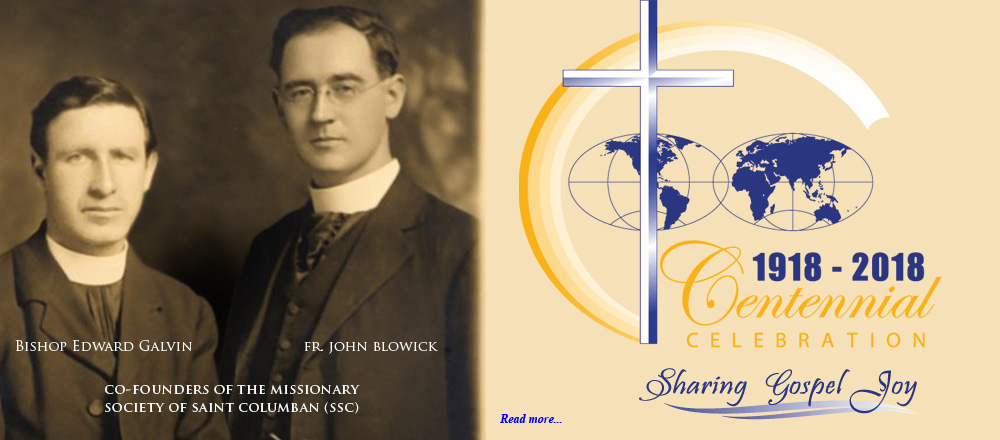
With gratitude to God in our hearts, the Missionary Society of St. Columban launched the year-long Centenary Celebration in November 2017 and will culminate in November 2018. The Columban Society was founded on June 29, 1918 by two young Irish diocesan priests, Fr. Edward Galvin and Fr. John Blowick, who answered the invitation of Christ to: “Go and make disciples of all nations” (Mt. 28:19) . . .

From the Editor
By Arlenne Villahermosa
As the Missionary Society of St. Columban continues the celebration of its 100th founding anniversary this year, Misyononline.com will feature in this issue stories and testimonies of people who have been touched by the love of God as their lives intertwined with the faith-witnessing journey that the Columban missionaries had lived-out through the years. This issue also features insights and reflections on mission by a Columban lay missionary and a Columban student who is currently on his First Mission Assignment to Pakistan . . .
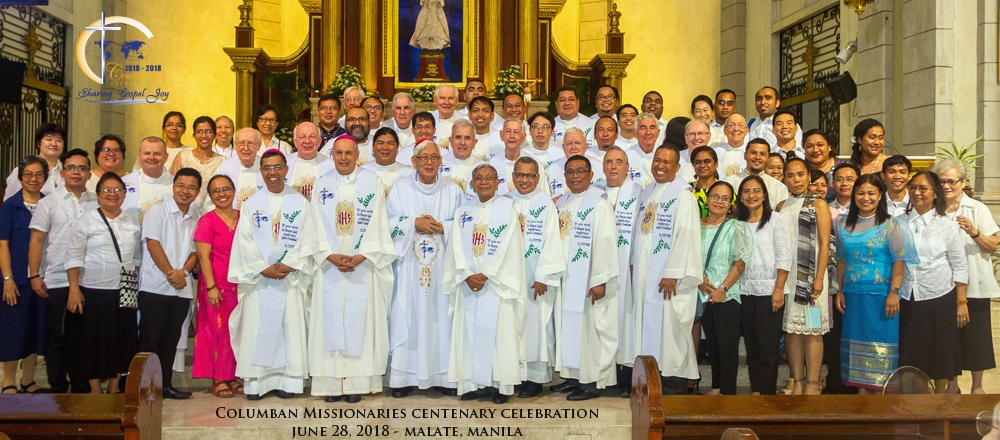

A Love Story with the Columban Fathers
By Msgr. Crisostomo A. Cacho
Msgr. Cacho, from San Marcelino, Zambales, is the Vicar-General of the Diocese of Iba, a position that he has held since 1978 when Bishop Henry Byrne was the Ordinary of the Diocese. He is the President of Columban College since 2007, and the fourth priest to be ordained for the Diocese of Iba, one of the first fruits of the Columban apostolate to put up a diocesan clergy.
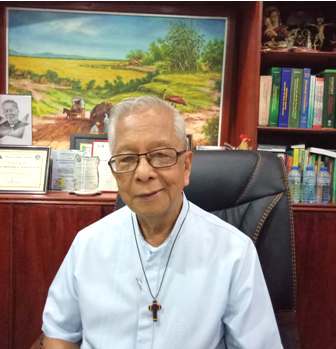
My love story with the Columban Fathers started when I studied in a public elementary school at Linasin, San Marcelino, Zambales. I would often see them at the convento, but my first close encounter with them was with Fr. Vincent Lyons. Father Lyons brought catechists to our school to conduct catechism classes . . .

Multiplying Oneself Through Columban Mission
By Franklin Hidalgo
Frank is an electrical engineer who has managed his own business for 30 years. He is a native of La Paz, Iloilo City but has settled in Las Piñas with his family for many years.
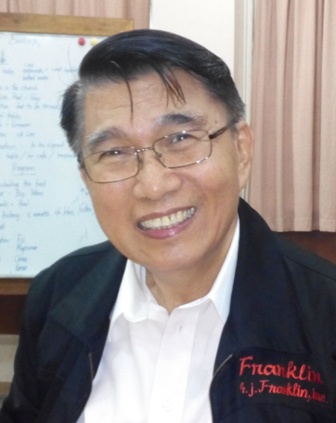
When my wife, Liberty, made contact with the Columban Missionaries in the late ‘90s, she started receiving Misyon magazine, then, later, the Columban Mission newsletter. I did not bother to read them. When she left for the US to take care of our very young, one and only grandson, I was left behind. The newsletters continued to come to the house. So I started reading them and got to know about the Columban Missionaries. I was inspired to learn how they cared for my countrymen; for the many years of sacrifices they had made to help the poorest of the poor. I had probably been to these far distant places where the Columban Missionaries went. It made me realize the difficulties that these missionaries experienced and yet they gave their lives and their hearts to serve the people. How noble it is ! . .

Family Traces Footsteps of Martyred Uncle
By Verne Turner and Vernon Douglas
This is an excerpt from an article published in New Zealand Catholic. We are publishing this on the occasion of Fr. Vernon’s 75th death anniversary on July 27, 2018.
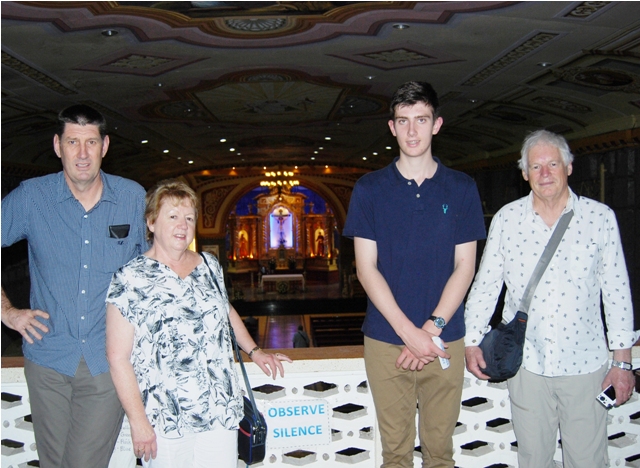
L to R: Vernon Douglas, Verne Turner, Brendan Douglas and Cliff Turner
Douglas Family at St. Mary Magdalene Church, Pililla, Rizal, September 28, 2016
Fr. Vernon Douglas was deeply loved by the Douglas family from Johnsonville in Wellington, New Zealand. Verne and Vernon were named in his memory. Fr. Vernon’s deep faith led him to become a Columban missionary assigned to the Philippines during the Second World War . . .

Blueprint
By Beth Sabado
When Beth Sabado moved to Hong Kong in 2012 as the Coordinator of the Columban Lay Missionary Central Leadership Team, she joined an ecumenical radio ministry recording some reflections for a radio program, which she continues to participate in up to present. This article will soon be broadcasted in Hong Kong this August 2018. Beth is currently the Coordinator of Columban Lay Mission–Philippines based in Cubao, Quezon City.
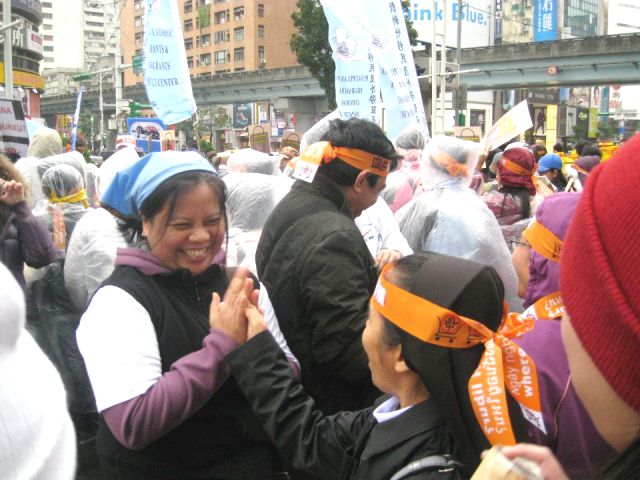
The author in Taiwan, 2011
When I was young, I had my life all planned. My childhood blue print included school graduations, finding a stable career, how much money to save, to own a house, buy cars, when to settle down, number of kids to raise with their possible names, where to reside, where to retire, what to do during retirement and a lot more dreams . . .

Light
By Jerry Lohera
Jerry is a Columban seminarian from Misamis Oriental who left for Pakistan in July 2017 for a two-year First Mission Assignment.
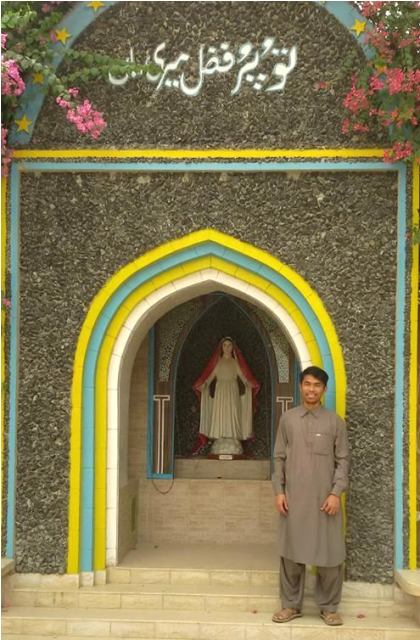
Prior to my missionary assignment in Pakistan, I had been told that the electric power system of the country is less developed; it is normal to have brownouts within a day. True! Electricity is an essential infrastructure that all poor countries must develop to keep and to attract more businesses, local and foreign. But I am not here to dwell on this matter. Rather, let me tell you of a more powerful light that we are enjoying despite the poor condition . . .

I grew up witnessing the love and hate relationship of my parents, including the few attempts of my mom to stowaway every time my dad would violently hit her. But their message for us their children was very clear, to always choose marriage and family over challenges and sufferings.
The modern time shows us a great deal of broken marriages and my heart goes especially to the rebellious children who could hardly accept their family situation. I am in my 30s now and I hear people commenting from time to time that “marriage is but a piece of paper”. I don't intend to live in a dreamy world but I still do believe in marriage and I pray for one for myself. But I must admit that I sometimes get affected by how some of my good friends suffered in marriage.

I will turn their mourning into joy,
I will show them compassion and have them rejoice after their sorrows.
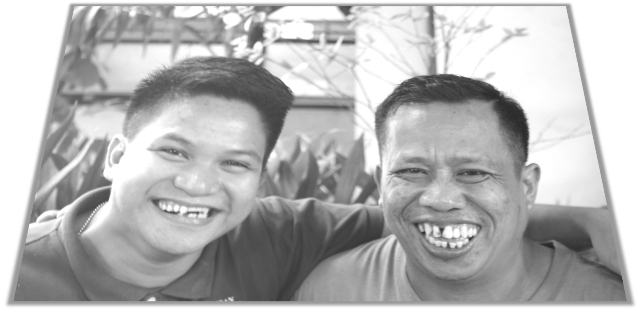
~ Jeremiah 31:13b

A Love Story with the Columban Fathers
By Msgr. Crisostomo A. Cacho
Msgr. Cacho, from San Marcelino, Zambales, is the Vicar-General of the Diocese of Iba, a position that he has held since 1978 when Bishop Henry Byrne was the Ordinary of the Diocese. He is the President of Columban College since 2007, and the fourth priest to be ordained for the Diocese of Iba, one of the first fruits of the Columban apostolate to put up a diocesan clergy.

My love story with the Columban Fathers started when I studied in a public elementary school at Linasin, San Marcelino, Zambales. I would often see them at the convento, but my first close encounter with them was with Fr. Vincent Lyons. Father Lyons brought catechists to our school to conduct catechism classes.
I went to Southern Zambales High School, the name of which was later changed to St. William’s High School when the Columban Fathers took over its administration. This was the beginning of my immersion into the works of the Church.
My 3rd and 4th years of High School were spent as a convent boy with Fr. Cornelius O’Connell, the parish priest. I went with the Columban priests to the barrios of the parish and witnessed their work among the people, especially among the poor. Those two years were filled with admiration of the zeal the Columbans showed in their ministry as priests. I was inspired to be part of what I witnessed.
One night, after graduation, I told Fr. O’Connell, my idol, that I wanted to become a priest. In June 1959, Fr. William Sullivan, together with my father and two friends, accompanied me to Guadalupe Minor Seminary in Makati.
My seminary life was a journey of trials, joy and full of aspirations to be like Fr. O’Connell in the future. Precious were the days when Fr. O’Connell and Bishop Henry Byrne visited us at the Seminary, to the envy of the Seminarians from other dioceses.
One day I applied to the Columban Missionaries in Nebraska. The vocation director replied, “We don’t accept Filipinos yet in our Society. Your bishop can use you in your diocese.” None of the Columbans in the Philippines knew about it. I was already a priest when I revealed that to Fr. Donal O’Dea.

Msgr. Cacho with Columban Fathers Colm McKeating and Bernard Mulkerins at the Columban House in Baretto, Olongapo City
Fr. O’Connell brought me several times to the Columban gatherings where I learned how to play cards and was exposed to happy hour and table wine. When I saw the priests in their spirit of togetherness, it added to my vision of a priest, one who is very human, yet chosen by God to do His work among the people.
I was ordained a priest by Bishop Byrne at St. William the Hermit Parish on December 20, 1969. My family could not afford any kind of preparation for celebration so Fr. O’Connell took it upon himself to make all the preparations needed. Everything was simple yet meaningful. I was truly grateful and happy.

Diocese of Iba joins Columban Centenary celebration
St. Columban Parish, Olongapo City, Zambales, July 3, 2018
When I think of the Columbans, I remember their spirit of camaraderie and the virtue of simplicity and availability to the people. In the parish, Bishop Byrne would sit down at meetings of the various organizations, even if he had nothing to say because he wanted to be present to the people. The Columbans affirmed the enthusiasm of the parish workers and volunteers, valued and appreciated their sacrifices. This is a legacy from the Columbans which I keep in my heart and try to pass on to others.
The whole Diocese of Iba was sad when the Columban Missionaries left. But the Columbans left behind an imprint of God’s love that forms part of our story and history, which we will always remember and retell with great joy and gratitude.

L to R: Fr. Rolly Aniscal, Fr. Daniel Presto, Msgr. Crisostomo Cacho,
Fr. Raymann Catindig and Fr. Paul Glynn
Inauguration and blessing of the new building dedicated to Bishop Henry Byrne, MSSC, JCD, DD, June 7, 2017, Columban College, Olongapo City
Blueprint
By Beth Sabado
When Beth Sabado moved to Hong Kong in 2012 as the Coordinator of the Columban Lay Missionary Central Leadership Team, she joined an ecumenical radio ministry recording some reflections for a radio program, which she continues to participate in up to present. This article will soon be broadcasted in Hong Kong this August 2018. Beth is currently the Coordinator of Columban Lay Mission–Philippines based in Cubao, Quezon City.

The author in Taiwan, 2011
When I was young, I had my life all planned. My childhood blue print included school graduations, finding a stable career, how much money to save, to own a house, buy cars, when to settle down, number of kids to raise with their possible names, where to reside, where to retire, what to do during retirement and a lot more dreams.
I had plans, but God had another plan and it was the best one. Making a decision to follow the “road less travelled” demanded that I let go of the blueprint. I believe that “God isn’t looking for people of great faith, but for individuals ready to follow Him”.
There’s a passage in the Bible that says, “O Lord, you have searched me and known me! You know when I sit down and when I stand, you discern my thoughts from afar.”
My journey in the missions has led me to an awareness of and involvement with issues concerning justice, peace and integrity of creation. I have also come to appreciate religious and cultural differences. That required a complete head to heart conversion on how I saw God. Now I see God as a person present to all peoples and in all religions, not just associated with Church and Christians.
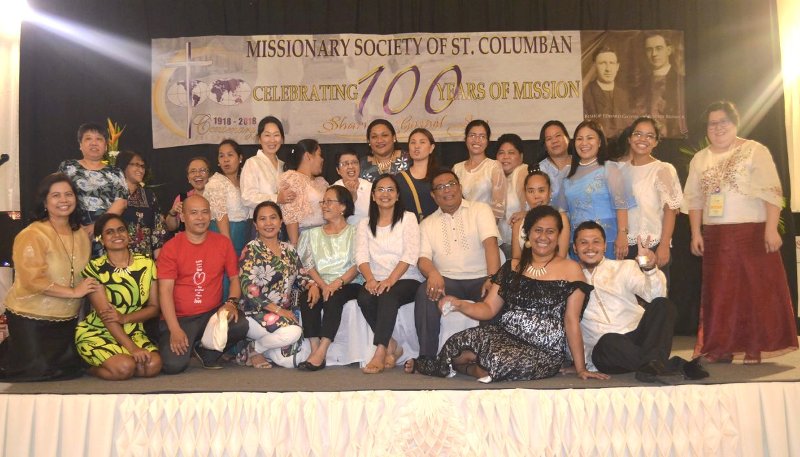
Beth (leftmost) with Columban missionaries, June 28, 2018
I firmly believe that our differences must not divide but unite us and therefore, must be celebrated. It is my hope that one day people call each other by name and not by labels of creed and race.
I see God as limitless, no boundaries, and a Being who is present to everyone, and in the midst of every group, regardless of tribe and tongue, people and nation.
Celebrating 100 Years of Mission in the Philippines
By Arlenne Villahermosa

With gratitude to God in our hearts, the Missionary Society of St. Columban launched the year-long Centenary Celebration in November 2017 and will culminate in November 2018. The Columban Society was founded on June 29, 1918 by two young Irish diocesan priests, Fr. Edward Galvin and Fr. John Blowick, who answered the invitation of Christ to: “Go and make disciples of all nations” (Mt. 28:19).
As we celebrate our centennial year, we give thanks to all the peoples who have journeyed with us through the years – for their generosity, support, friendship, care and faithfulness, without which we would not have come this far. This celebration is to rejoice with each of them who walked with us in the mission as we give thanks and praise to God for all the wonders He has done.
In the Philippines, the celebrations were done in the different parts of the country where the Columbans used to work and continue to work up to the present.

In Negros, the launching of the centennial celebration was held on November 19, 10:00am at San Columbano, Batang, Himamaylan, Negros Occidental with a Mass, followed by the launching of the Hiligaynon version of Laudato Si’ animation video. The centenary bracelets were given to the Mission Partners as a way of thanking them for the significant contribution they have given to the Columban mission.
In Luzon, a simple Mass was held on November 23, 5:00pm, the feast of St. Columban, in Singalong to open the centennial celebration. This was followed by a meal shared by the Columban sisters, lay missionaries, students, staff, invited guests and priests. A multi-cultural concert culminated the celebration to the delight of all. Bishop Antonio Tobias, Bishop of Novaliches Diocese, graced the occasion.
In Mindanao, a Eucharistic celebration was held on November 24, 6:30pm at St. Augustine Metropolitan Cathedral, Cagayan de Oro City. The Mass was presided by Archbishop Antonio Ledesma of the Archdiocese of Cagayan de Oro, concelebrated by the Columban priests and priests coming from other arch/dioceses in Mindanao, and was attended by the religious, mission partners and friends from different parishes. The following day, November 25, a lecture on “Renewing our commitment to care for Mother Earth” was given by Rev. Fr. Reynaldo Raluto, PhD of the Archdiocese of Cagayan de Oro, followed by the launching of the Cebuano version of the Laudato Si’ video. Also, a photo exhibit of the journey of the Columban Missionaries was on display and a book launching of “Salamat” was made in celebration of 25 years of the Columban Lay Missionaries. To close the event, the “Growing 100 Rainforest Trees in Higaonon Tribal Domain” project was launched in partnership with the Higaonon Tribe to commemorate the 100 years of the Society. The centenary bracelets were given to all those who were present during the occasion as a token of appreciation and gratitude. This celebration took place at Dynasty Court Hotel in Cagayan de Oro City. It was a moment of joy and gratitude renewing one’s commitment to participate in the mission of Christ as well as an occasion to celebrate the bonds of friendship forged through the years.

The regional-wide centenary celebration was held on June 28 in Malate, Manila. The atmosphere was festive; banners about the Columban mission hang around the compound of the church; flags from the different countries were on display inside the church and a drum and bugle corps welcomed the guests while waiting for the Mass to start. The Eucharistic celebration was held at 9:30 am presided by His Eminence Gaudencio Cardinal Rosales at Our Lady of Remedies Parish, Malate, Manila. The centenary altar cloth was offered and used at mass. It was graced by the presence of the Papal Nuncio Archbishop Gabriele Giordano Caccia, bishops, priests, religious, friends and guests from the different arch/dioceses in the country. A big number of the mission partners, supporters and benefactors coming from different parishes, schools and organizations were greatly evident. From Malate church, the people were ushered to Palacio de Maynila where the meal and cultural presentation were to take place.
At Palacio de Maynila, banners showing the mission of all the regions/mission units where the Columbans are working were on display at the lobby; a photo booth was made available for those who wanted to document memories on pictures; and products from the various income-generating projects and books written by Columban Missionaries were available for sale. The Columban Mission Special Edition newsletter, the book “Remembering Fr. Niall O’Brien” and other items were given for free to those interested.
The guests were entertained by the cultural presentations of the Columban missionaries – priests, lay and students. The Tagalog version of the Laudato Si’ video was launched during the occasion. All those who were present received the centenary bracelets as token of appreciation. The affair ended with gladness and joy, giving thanks to the Creator and to all who were present.

On July 3, the Columban Missionaries celebrated the centenary with a mass with the people of Zambales. The event was hosted by Iba Diocese as a way of showing their gratitude to the Columban Missionaries for the contributions they have made to the diocese and her people. The mass took place at St. Columban Parish, followed by the blessing of the columbarium, located at the side of the church, where the bodies of the six Columban priests who died in Zambales were placed, and the blessing and unveiling of the statue of St. Columban at the church compound. Then the people were treated to a sumptuous meal and entertained by the cultural presentations of the Columban lay missionaries and students and the Philippine folk dances by the students of St. Columban College.
There are many reasons to celebrate 100 years of mission, and many more reasons to celebrate love, life and friendships in the mission.

Family Traces Footsteps of Martyred Uncle
By Verne Turner and Vernon Douglas
This is an excerpt from an article published in New Zealand Catholic. We are publishing this on the occasion of Fr. Vernon’s 75th death anniversary on July 27, 2018.

L to R: Vernon Douglas, Verne Turner, Brendan Douglas and Cliff Turner
Douglas Family at St. Mary Magdalene Church, Pililla, Rizal, September 28, 2016
Fr. Vernon Douglas was deeply loved by the Douglas family from Johnsonville in Wellington, New Zealand. Verne and Vernon were named in his memory. Fr. Vernon’s deep faith led him to become a Columban missionary assigned to the Philippines during the Second World War.
In 1943, Japanese soldiers believed that the local guerillas had shared valuable information with Fr. Vernon; so forced him to tell what he knew. With the seal of confession, he refused to talk and, for that, he was tortured and finally killed.
Reflecting on Fr. Vernon’s suffering at the hands of the Japanese which led to his death, the Columban Missionaries in the Philippines decided to make a pilgrimage on September 28, 2016 to Pililla, Rizal and Paete, Laguna. Four members of our family were fortunate to join that pilgrimage – Vernon Douglas, his son Brendan, Verne Turner and her husband Cliff.
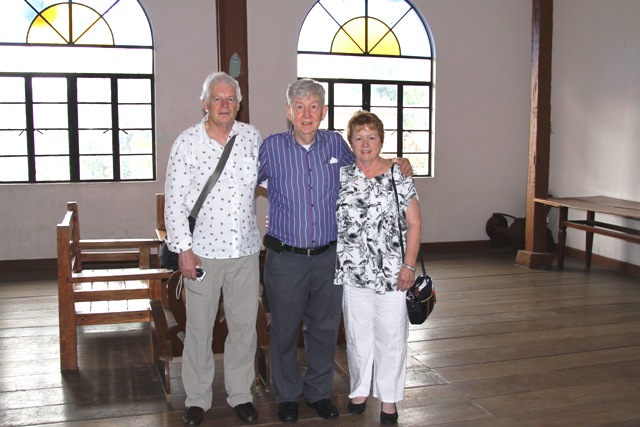
Cliff and Verne Turner with Fr. Michael Mohally at the sala of the convent in Pililla where Father Vernon lived
To see the beautiful 430-year-old Spanish church in Pililla and the thriving loving Christian Community confirmed to us that the work started by our uncle over 70 years ago continues today. At St. Mary Magdalene Parish, we strongly felt Fr. Vernon’s presence. We saw the baptistery register with his hand-written entries, a real proof that he had been there.
We went upstairs and stood in the large room attached to the church where Fr. Vernon lived. It was a joy to imagine what life in the Philippines might have been like for him. But, it was also painful to think that it was there that he was first questioned by the Japanese soldiers, dragged downstairs and thrown on a truck that would take him to Paete, a journey of about five hours at that time. For a foreign young man of 33 years, it must have been an incredibly frightening experience.
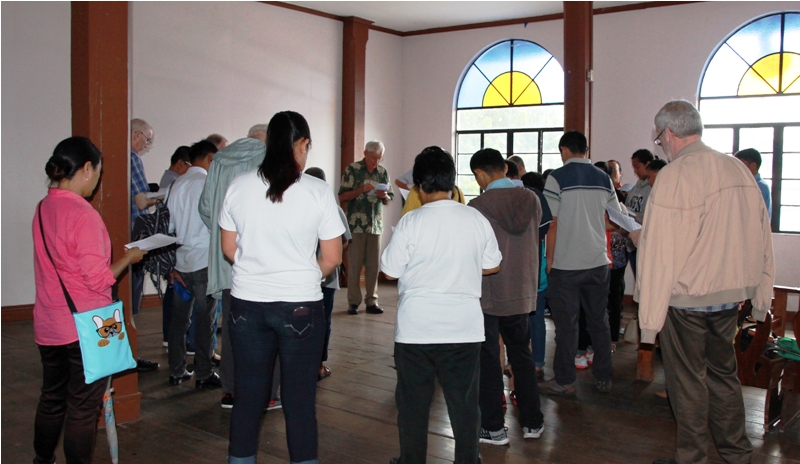
Pilgrims having a prayer service
In Paete, we talked to two elderly women, Dominga Dayocot and Aurelia Cadapan, who had both seen Fr. Vernon tied to a pillar in the church at Paete. We were deeply moved at St. James the Apostle Church when we touched the pillar to which he was tied and tried to imagine the fear and pain he must have experienced.
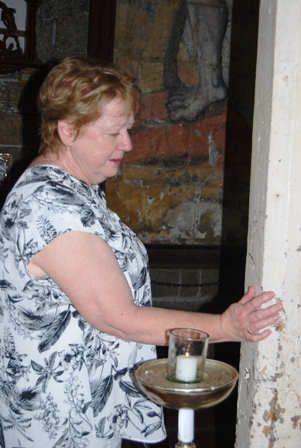
Verne touching the pillar where Father Vernon was tortured by the Japanese Imperial army, St. James the Apostle Church, Paete, Laguna
The pilgrimage ended with a concelebrated Mass giving thanks for the life of Fr. Vernon. We felt the joy of Fr.Vernon’s spirit present with us.
Following in our uncle’s footsteps, to see where he had prayed, slept, lived and ultimately died was truly overwhelming – a pilgrimage we feel so very privileged to have been able to make.
From the Editor
By Arlenne Villahermosa

As the Missionary Society of St. Columban continues the celebration of its 100th founding anniversary this year, Misyononline.com features in this issue stories and testimonies of people who have been touched by the love of God as their lives intertwined with the faith-witnessing journey that the Columban missionaries had lived-out through the years. This issue also includes insights and reflections on mission by a Columban lay missionary and a Columban student who is currently on his First Mission Assignment to Pakistan.
Life in the mission is encountering the different faces of God in the culture of a people different from our own, in the language spoken far from our own, in a country with its own unique beauty and challenges, in a way of life new to us, in a religion unlike our own, and be transformed by all of these experiences.
Being on mission is opening up of one’s self to the newness and vastness of God’s creation, allowing one’s self to be surprised in meeting God outside of one’s own confines, recognizing the beauty of our differences and the challenges as well, and engaging the other in a healthy growing relationship, respecting and understanding each other’s uniqueness. It calls for an open mind and heart, one that is able to transcend beyond one’s own way of thinking and seeing things, and being able to understand the other from where they are at.
The journey of the Columban missionaries in all the regions and mission units they were assigned (and a good number are still there) has been a transforming one for themselves and for the people they had met along the way, worked with and made friends with. And this is the journey we are celebrating in this centenary – one of joy and thanksgiving, building and strengthening of relationships founded in faith and in the love of God, and sharing this love to all peoples and to all of God’s creation.
Multiplying Oneself Through Columban Mission
By Franklin Hidalgo
Frank is an electrical engineer who has managed his own business for 30 years. He is a native of La Paz, Iloilo City but has settled in Las Piñas with his family for many years.

When my wife, Liberty, made contact with the Columban Missionaries in the late ‘90s, she started receiving Misyon magazine, then, later, the Columban Mission newsletter. I did not bother to read them. When she left for the US to take care of our very young, one and only grandson, I was left behind. The newsletters continued to come to the house. So I started reading them and got to know about the Columban Missionaries. I was inspired to learn how they cared for my countrymen; for the many years of sacrifices they had made to help the poorest of the poor. I had probably been to these far distant places where the Columban Missionaries went. It made me realize the difficulties that these missionaries experienced and yet they gave their lives and their hearts to serve the people. How noble it is!
At that time I was looking for a way to multiply myself, so to speak, in order to reach out to the poor in many places of the country. I would be very limited if I did it alone. So I prayed to God for direction. I was then led to the Columban Missionaries. It just came as an inspiration. If I want to multiply myself, I’ll do it with the missionaries because they go out to many places all over the world. And if I become part of the Columban Missionaries, I can reach out to many poor people as well. So it was an answered prayer.

Franklin (leftmost) with Columban mission partners at the diaconate ordination of Rev. Louie Ybañez, Columban House of Studies, Cubao, Q.C., May 13, 2018
One day I visited Singalong House when Fr. Pat O'Donoghue was still the regional director. I handed him a gift for the mission. I was happy to be able to do it and I want to continue doing this.
Years passed and on April 7, 2017 I had a heart bypass. I asked for prayers from the Columban Fathers. It played a very important part in my life now. I thank God for having extended my life and for giving me a purpose-driven life. I have more time to continue my advocacy and to continue being a mission partner.
Our Hideaway
Light
By Jerry Lohera
Jerry is a Columban seminarian from Misamis Oriental who left for Pakistan in July 2017 for a two-year First Mission Assignment.

Prior to my missionary assignment in Pakistan, I had been told that the electric power system of the country is less developed; it is normal to have brownouts within a day. True! Electricity is an essential infrastructure that all poor countries must develop to keep and to attract more businesses, local and foreign. But I am not here to dwell on this matter. Rather, let me tell you of a more powerful light that we are enjoying despite the poor condition.
Holy Week marked my introduction to pastoral work here in Pakistan after language studies and I had mixed feelings about it. We had incessant meetings with the people in the small Christian villages at evening time wherein we were dependent on the moonlight and flashlights for light while celebrating Holy Masses in their mud houses. The light from the moon reminded me of my village and childhood life too. The difference now is that I am not in my village; I am no longer a child and I am meeting strangers.

Jerry (leftmost) with missionaries in Pakistan
But why do we go in the evenings and not on the broad daylight? In Badin parish, where the Columban missionaries are actively working, most of the parishioners are peasants. They work all day long and their most preferable time to attend Holy Mass is at night. Traversing through poor roads in the middle of the wheat or rice fields or of nowhere at night with the bright moonlight is somehow relaxing.
But there is another light that I see—the faces and the eyes of the children. They, too, are actively participating at the Holy Mass. This is really what particularly makes me happy. Someone said, “If a priest no longer finds a child in the Mass, that church is dying”. Here, children’s participation is very evident during the Mass and that says a lot about the future of the church in Pakistan. However, awareness comes to me that there is still a wider task to unravel the potential of these children. A lot of work needs to be done yet and while we are trying to evangelize them in various ways, we are opening ourselves, too, to be evangelized by them.

"The heavens are telling the glory of God!"
Moon in Pakistan
Peace by Peace
I will turn their mourning into joy,
I will show them compassion and have them rejoice after their sorrows.

~ Jeremiah 31:13b

Do not forget that when sovereigns are at war they can no longer busy themselves with their administration; justice is not distributed; no care is taken of the people; and this alone is your sovereign charge, this the main point of your duty as kings.

~ St. Elizabeth of Portugal, Queen and Patroness of Peace (1271-1336)

Excessive faith without sufficient wisdom leads to blind faith, while excessive wisdom without sufficient faith leads to undesirable cunning. Too much energy combined with weak concentration leads to restlessness while strong concentration without sufficient energy leads to indolence.
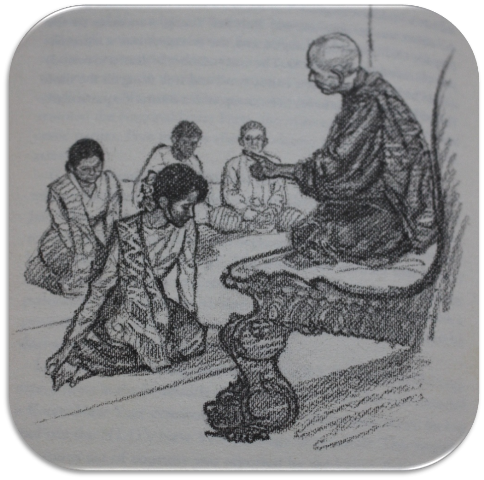
~ Aung San Suu Kyi, Letters from Burma

Saying the mantra is like unlocking the door of our heart. The mantra is like the key unlocking the door to allow the pure light of love to flood in. Although powerful, it is a gentle process. Do not expect dramatic miracles. In fact, do not expect anything. Be humbly content every morning and evening, to return simply to the practice. In the practice itself you will find the powers of gentleness, forgiveness and compassion, all revealing themselves. Do not fear their power to change you.
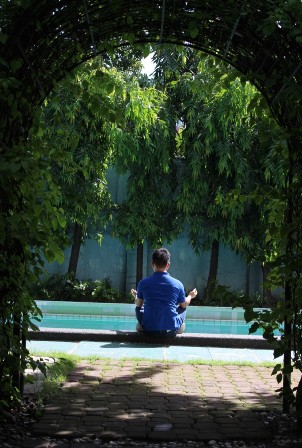
~ The Heart of Creation, Daily Reading with John Main: Silence and Stillness in Every Season

Whether the potentials for cultural enrichment are realized or whether our world continues down the slippery slope towards cultural bankruptcy, will depend greatly on how we humans respond to this new situation that is opening up before us. Will we opt for appreciating, purifying and transforming the rich cultural heritage that has been passed on to us, or will we allow it to disintegrate before our eyes by reckless fascination with greed, power and endless possession of material goods? More than ever we are called to live by choice as to what furthers life.

~ Peter Leonard, Yeast in the Dough: Heightening an Awareness of the Nature and Significance of Culture (1933-2003)

To Search Is To Find
I grew up witnessing the love and hate relationship of my parents, including the few attempts of my mom to stowaway every time my dad would violently hit her. But their message for us their children was very clear, to always choose marriage and family over challenges and sufferings.
The modern time shows us a great deal of broken marriages and my heart goes especially to the rebellious children who could hardly accept their family situation. I am in my 30s now and I hear people commenting from time to time that “marriage is but a piece of paper”. I don't intend to live in a dreamy world but I still do believe in marriage and I pray for one for myself. But I must admit that I sometimes get affected by how some of my good friends suffered in marriage.
The phrase “love and hate relationship” can sometimes be heard to refer to a relationship where the couples could be seen as loving each other and at other times shouting at each other. Hate may not necessarily be the right word for this, rather, anger expressed in many different ways. And anger is not equivalent to hate. Jesus got angry with those who were selling goods inside the temple, but he did not hate the people. In fact, he instructed them on what was right – that the temple was not a place for trading and selling goods.
All vocations in life are dynamic, namely we are continually in the process of becoming what we are called to be. Couples are constantly becoming married, priests are always becoming priests, and religious always becoming religious. In the journey, there are steps forward and steps backward. There is the constant challenge and opportunity to find peace and be at peace in the relationship.
Couples live their life in a community. When problems arise and differences seem to be irreconcilable, is there help available to the couples? It is a challenge to the church and to the Christian community to be a caring body, to help people celebrate their love and put their “fighting” into perspective. The persons experiencing pain in the relationship may find it difficult to seek help, but if they are assured of the support and concern of their friends or someone in the community, they may find a way forward that will bring peace. A good friend of the couple may be the one to encourage them in their search.
During the morning mass of Pope Francis on May 25, 2018, he stressed that marriage “silently preaches” that “love is possible”. He further said, “It’s true that there are difficulties. There are problems with children or with the couple themselves, arguments and fights… but the important thing is that the flesh remains one, and you can overcome, you can overcome, you can overcome.” And he added, “Marriage is not only a sacrament for them, but also for the Church, a sacrament, as it were, that attracts attention: “See, love is possible! And love is capable of allowing you to live your whole life in love: in joy and in sorrow, with the problems of children, and their own problems… but always going forward. In sickness and in health, but always going forward. This is beautiful.”
“Life is not a bed of roses,” as they say. If couples can accept that difficulties, differences and sufferings are part of living, then maybe they can continue to search for answers and explore ways to grow into the relationship, to rediscover the love that they have for each other.



